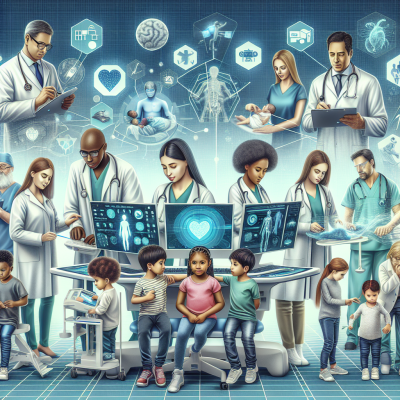
Revolutionizing Pediatric Healthcare Through Innovation
The landscape of pediatric healthcare is undergoing a significant transformation, driven by groundbreaking innovations in both treatment and technology. As children represent our future, there is an increasing urgency to provide them with the highest quality of care possible, tailored to their unique developmental needs. From AI-powered diagnostics to personalized medicine and digital therapeutics, the evolution of healthcare technology is ushering in a new era in pediatric care.
Enhancing Diagnosis Accuracy with Artificial Intelligence
Artificial Intelligence (AI) is rapidly changing the way healthcare providers diagnose and treat diseases in children. Traditional diagnostic methods often struggle to account for the complex ways in which illnesses manifest across different age groups. AI-powered tools can analyze massive datasets, including electronic health records (EHRs), genomic data, and medical imaging, to identify patterns and predict potential health issues more accurately and at a much earlier stage.
Examples of AI Applications in Pediatrics:
- Automated analysis of pediatric radiology scans, enhancing detection of abnormalities like tumors and congenital conditions.
- Predictive analytics that forewarn health providers of deteriorating patient conditions.
- Virtual assistants for pediatric triage, providing preliminary symptom assessment through chatbots or mobile applications.
Telehealth: Bridging Gaps in Pediatric Access
One of the most influential changes in recent years is the widespread adoption of telehealth. Especially invaluable in remote and underserved communities, telemedicine platforms enable families to consult pediatric specialists regardless of geographical barriers. This technology not only increases access but also reduces the stress and cost associated with in-person visits.
Telehealth Benefits in Pediatric Care Include:
- Real-time video consultations with pediatricians and sub-specialists.
- Prompt follow-ups and medication management from home.
- Integration with wearable devices for continuous health monitoring.
Wearable Technology: Real-Time Monitoring for the Youngest Patients
Wearable devices in pediatrics are being used to track a wide range of metrics such as heart rate, oxygen saturation, sleep patterns, and seizure activity. These insights are critical in managing chronic diseases like Type 1 diabetes, epilepsy, and asthma. For premature infants or children with cardiovascular conditions, wearables can offer life-saving early warnings of complications.
Current Wearables Making an Impact:
- Smart glucose monitors that sync data with caregiver apps.
- Seizure-detecting wristbands for children with epilepsy.
- Infant monitoring socks for tracking vital signs during sleep.
Genomics and Personalized Medicine in Pediatrics
One of the most promising aspects of pediatric healthcare innovation is the rise of genomics and personalized medicine. By decoding a child’s genetic makeup, clinicians can provide targeted therapies with greater effectiveness and fewer side effects. This approach is especially crucial in treating rare genetic disorders and pediatric cancers, where a one-size-fits-all model often fails.
Breakthroughs in Pediatric Genomics Include:
- Whole genome sequencing used to diagnose rare developmental conditions.
- Pharmacogenomics to determine the most effective medications for individual genetic profiles.
- Gene therapy applications in treating previously incurable diseases like spinal muscular atrophy (SMA).
Virtual Reality and Augmented Reality in Pediatric Therapy
Virtual Reality (VR) and Augmented Reality (AR) are making immense contributions in pediatric mental health and rehabilitation. These tools create immersive environments that help children manage pain, reduce anxiety, and stay engaged during physical or occupational therapy.
Innovative Uses of VR and AR:
- Distraction tools during medical procedures such as injections or blood draws.
- Rehabilitation games for children with developmental delays or motor skill challenges.
- Behavioral therapy platforms using interactive simulations.
Cross-Industry Collaboration: The Catalyst for Change
What truly fuels these advancements is the growing collaboration between medical researchers, pediatric healthcare professionals, and tech developers. These joint partnerships ensure that the latest innovations are not only scientifically robust but also child-friendly and clinically feasible.
Successful Collaborative Models:
- Hospitals partnering with startups to co-create pediatric-specific medical devices.
- Academic researchers working with AI companies to develop data-driven diagnostic algorithms.
- Government and private sector investments in pediatric innovation incubators.
Challenges and the Road Ahead
Despite the momentum, several challenges remain. Regulatory hurdles, data privacy concerns, and ensuring equitable access to these technologies must be addressed. Additionally, health systems must train staff and redesign workflows to embrace these advances effectively.
Conclusion: Building a Healthier Future for the Next Generation
Innovations in pediatric healthcare are reshaping the way we treat and support children through all stages of growth and development. The synergistic integration of treatment advancements and technology offers immense potential to improve outcomes and quality of life for young patients.
With continued investment and cross-sector collaboration, the future of pediatric healthcare looks not only more technologically advanced but also more personalized, accessible, and compassionate. As we move ahead, ensuring that every child has access to these life-enhancing innovations should remain our collective priority.


Leave a Reply